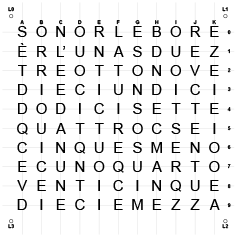1006 typedef union {
1007 struct {
1008 unsigned LATA0 :1;
1009 unsigned LATA1 :1;
1010 unsigned LATA2 :1;
1011 unsigned LATA3 :1;
1012 unsigned LATA4 :1;
1013 unsigned LATA5 :1;
1014 unsigned LATA6 :1;
1015 unsigned LATA7 :1;
1016 };
1017 ......
1048 } LATAbits_t;
1049 extern volatile LATAbits_t LATAbits @ 0xF89;
56 #define Row0 LATAbits.LATA1
57 #define Row1 LATAbits.LATA2
58 #define Row2 LATAbits.LATA3
59 #define Row3 LATAbits.LATA4
60 #define Row4 LATAbits.LATA5
61 #define Row5 LATCbits.LATC0
62 #define Row6 LATCbits.LATC1
63 #define Row7 LATBbits.LATB1
64 #define Row8 LATBbits.LATB2
65 #define Row9 LATBbits.LATB3
Most of the I/Os from all the ports are used to drive rows and columns, the ones not busy for other functions. To have a more mnemonic naming I've further defined the ports. Beside the definitions for the rows.
32 void SetRow(unsigned char Row)
33 {
34 switch (Row)
35 {
36 case 0:
37 Row0 = ON;
38 break;
39
40 case 1:
41 Row1 = ON;
42 break;
43
44 case 2:
45 Row2 = ON;
46 break;
47
48 case 3:
49 Row3 = ON;
50 break;
51
52 case 4:
53 Row4 = ON;
54 break;
55
56 case 5:
57 Row5 = ON;
58 break;
59
60 case 6:
61 Row6 = ON;
62 break;
63
64 case 7:
65 Row7 = ON;
66 break;
67
68 case 8:
69 Row8 = ON;
70 break;
71
72 case 9:
73 Row9 = ON;
74 break;
75
76 default:
77 SetRowOff();
78 break;
79 }
80 }
The rows are driven in sequential way, one by one every 1ms and it's easy to use those with this kind of definitions at runtime.
170 void WordSetting()
171 {
172 int i;
173
174 for(i=0; i<=MAXROW; i++)
175 {
176 Matrix[i]=0;
177 }
178
179 if(Min <= 30)
180 {
181 Matrix[6]=0b000000011110;
182 }
183 else
184 {
185 Hour++;
186 Matrix[7]=0b100000000000;
187 }
188
189 switch(Min / 5)
190 {
191 case 1:
192 case 11:
193 Matrix[8] = Matrix[8] | 0b000001111110;
194 break;
195
196 case 2:
197 case 10:
198 Matrix[9] = Matrix[9] | 0b111100000000;
199 break;
200
201 case 3:
202 case 9:
203 Matrix[7] = Matrix[7] | 0b001101111110;
204 break;
205
206 case 4:
207 case 8:
208 Matrix[8] = Matrix[8] | 0b111110000000;
209 break;
210
211 case 5:
212 case 7:
213 Matrix[8] = Matrix[8] | 0b111111111110;
214 break;
215
216 case 6:
217 Matrix[9] = Matrix[9] | 0b000000111110;
218 break;
219
220 default:
221 break;
222 }
223
224 if(!TimeSync)
225 {
226 switch(Min % 5)
227 {
228 case 1:
229 Matrix[0] = Matrix[0] | 0b000000000001;
230 break;
231
232 case 2:
233 Matrix[0] = Matrix[0] | 0b000000000001;
234 Matrix[1] = Matrix[1] | 0b000000000001;
235 break;
236
237 case 3:
238 Matrix[0] = Matrix[0] | 0b000000000001;
239 Matrix[1] = Matrix[1] | 0b000000000001;
240 Matrix[2] = Matrix[2] | 0b000000000001;
241 break;
242
243 case 4:
244 Matrix[0] = Matrix[0] | 0b000000000001;
245 Matrix[1] = Matrix[1] | 0b000000000001;
246 Matrix[2] = Matrix[2] | 0b000000000001;
247 Matrix[3] = Matrix[3] | 0b000000000001;
248 break;
249
250 default:
251 break;
252 }
253 }
254
255 Hour = Hour % 12;
256
257 if(Hour == 1)
258 {
259 Matrix[1] = Matrix[1] | 0b101000000000;
260 }
261 else
262 {
263 Matrix[0] = Matrix[0] | 0b111101101110;
264 }
265
266 switch(Hour)
267 {
268 case 1:
269 Matrix[1] = Matrix[1] | 0b000111000000;
270 break;
271
272 case 2:
273 Matrix[1] = Matrix[1] | 0b000000011000;
274 break;
275
276 case 3:
277 Matrix[2] = Matrix[2] | 0b111000000000;
278 break;
279
280 case 4:
281 Matrix[5] = Matrix[5] | 0b111111100000;
282 break;
283
284 case 5:
285 Matrix[6] = Matrix[6] | 0b111111000000;
286 break;
287
288 case 6:
289 Matrix[5] = Matrix[5] | 0b000000001110;
290 break;
291
292 case 7:
293 Matrix[4] = Matrix[4] | 0b000000111110;
294 break;
295
296 case 8:
297 Matrix[2] = Matrix[2] | 0b000111100000;
298 break;
299
300 case 9:
301 Matrix[2] = Matrix[2] | 0b000000011110;
302 break;
303
304 case 10:
305 Matrix[3] = Matrix[3] | 0b111110000000;
306 break;
307
308 case 11:
309 Matrix[3] = Matrix[3] | 0b000001111110;
310 break;
311
312 case 0:
313 Matrix[4] = Matrix[4] | 0b111111000000;
314 break;
315
316 default:
317 break;
318 }
319
320 SetColB();
321 }
For the columns is a little bit more complicated. All 12 of them must be set at in the 1ms cycle. In order to save precious time some tricks have been used.
The matrix has been defined with an array where the index defines the 16 bit variable corresponding to each row and the bits of each variable define the single column's LED, according to
this worksheet, and translated in code with the procedure WordSetting().
But the translation (to the left) is to heavy to be performed every 1ms, because it requires a lot of masking operations to set each port.
For this reason it is performed only at each change of display, i.e.: every minute and the result is buffered in a matrix of unsigned int. This wastes more memory (one int for each bit) but...
82 void SetColB(void)
83 {
84
85 char Col;
86 char Row;
87 unsigned int Mask;
88
89 for(Row = MINROW; Row <= MAXROW; Row++)
90 {
91 for(Col = MinCol; Col <= MaxCol; Col++)
92 {
93 Mask=BitMask[Col] & Matrix[Row];
94
95 if(Mask)
96 {
97 MatrixB[Row][MaxCol-Col] = ON;
98 }
99 else
100 {
101 MatrixB[Row][MaxCol-Col] = OFF;
102 }
103 }
104 }
105 }107 void SetCol(unsigned char Row)
108 {
109
110
111
112
113
114
115
116
117
118
119
120
121
122
123
124
125
126
127
128 ColA = MatrixB[Row][11];
129 ColB = MatrixB[Row][10];
130 ColC = MatrixB[Row][9];
131 ColD = MatrixB[Row][8];
132 ColE = MatrixB[Row][7];
133 ColF = MatrixB[Row][6];
134 ColG = MatrixB[Row][5];
135 ColH = MatrixB[Row][4];
136
137 LATD = Dbits.Port;
138
139 ColI = MatrixB[Row][3];
140 ColJ = MatrixB[Row][2];
141 ColK = MatrixB[Row][1];
142
143 LATE = Ebits.Port;
144
145 ColL = MatrixB[Row][0];
146
147 LATC = PORTC | Cbits.Port;
148 }
... the conversion is performed in 36us instead of hundreds of us. In this way it wastes only a little percent of 1ms period, allowing the dimming of the LEDs through the reduction of the duty cycle.
In order to save time during the frequently executed procedures other values, such as
BitMask[] and
DutyTab[] are pre-computed at startup or in less critical parts of the program.
182
183 void interrupt low_priority low_isr (void)
184 {
185 .......
244
245 if (PIR1bits.ADIF)
246 {
247 PIR1bits.ADIF=0;
248 DutyCycle=(ADRESH*LightIndx)>>8;
249
250 }
251
252 }
The ambient light is read by the LDR through ADC peripheral and...
160 void SetTimer1(unsigned char DutyCycle)
161 {
162
163 int Count = DutyTab[DutyCycle];
164 TMR1H = Count >> 8;
165 TMR1L = Count;
166 T1CONbits.TMR1ON=1;
167 }
...converted in time with the aid of DutyTab[] values.
In this way the TMR1 switches off the
columns dimming the LEDs brightness according to the computed duty cycle.
323 void TestMatrix()
324 {
325 static unsigned char Xcol;
326 static unsigned char Yrow;
327 int i;
328 static int j = 0;
329 static int k = 0;
330
331
332 for(i=MINROW; i<=MAXROW; i++)
333 {
334 Matrix[i]=0;
335 }
336
337 switch(j)
338 {
339 case 0:
340 WriteMatrixChar('G', 'O', 7, 1);
341 TestTime = 5000;
342 j++;
343 break;
344
345 case 1:
346 Matrix[Yrow]=0b0000100000000000 >> Xcol;
347 if((++Xcol)>MaxCol)
348 {
349 Xcol = MinCol;
350 if((++Yrow)>MAXROW)
351 {
352 Yrow=MINROW;
353 j++;
354 }
355 }
356 TestTime = 100;
357 break;
358
359 case 2:
360 Matrix[Yrow]=0b0000111111111111;
361 if((++Yrow)>MAXROW)
362 {
363 Yrow=MINROW;
364 j++;
365 }
366 TestTime = 300;
367 break;
368
369 case 3:
370 Matrix[0]=0b0000100000000000 >> Xcol;
371 Matrix[1]=0b0000100000000000 >> Xcol;
372 Matrix[2]=0b0000100000000000 >> Xcol;
373 Matrix[3]=0b0000100000000000 >> Xcol;
374 Matrix[4]=0b0000100000000000 >> Xcol;
375 Matrix[5]=0b0000100000000000 >> Xcol;
376 Matrix[6]=0b0000100000000000 >> Xcol;
377 Matrix[7]=0b0000100000000000 >> Xcol;
378 Matrix[8]=0b0000100000000000 >> Xcol;
379 Matrix[9]=0b0000100000000000 >> Xcol;
380 if((++Xcol)>MaxCol)
381 {
382 Xcol = MinCol;
383 j++;
384 }
385 TestTime = 300;
386 break;
387
388 case 4:
389 Matrix[0]=0b0000100000000000 >> Xcol;
390 Matrix[1]=0b0000010000000000 >> Xcol;
391 Matrix[2]=0b0000001000000000 >> Xcol;
392 Matrix[3]=0b0000000100000000 >> Xcol;
393 Matrix[4]=0b0000000010000000 >> Xcol;
394 Matrix[5]=0b0000000001000000 >> Xcol;
395 Matrix[6]=0b0000000000100000 >> Xcol;
396 Matrix[7]=0b0000000000010000 >> Xcol;
397 Matrix[8]=0b1000000000001000 >> Xcol;
398 Matrix[9]=0b0100000000000100 >> Xcol;
399 if((++Xcol)>MaxCol)
400 {
401 Xcol = MinCol;
402 j++;
403 }
404 TestTime = 300;
405 break;
406
407 case 5:
408 Matrix[0]=0b0000000000000100 << Xcol;
409 Matrix[1]=0b0000000000001000 << Xcol;
410 Matrix[2]=0b0000000000010000 << Xcol;
411 Matrix[3]=0b0000000000100000 << Xcol;
412 Matrix[4]=0b0000000001000000 << Xcol;
413 Matrix[5]=0b0000000010000000 << Xcol;
414 Matrix[6]=0b0000000100000000 << Xcol;
415 Matrix[7]=0b0000001000000000 << Xcol;
416 Matrix[8]=0b0000010000000001 << Xcol;
417 Matrix[9]=0b0000100000000010 << Xcol;
418 if((++Xcol)>MaxCol)
419 {
420 Xcol = MinCol;
421 j++;
422 }
423 TestTime = 300;
424 break;
425
426 case 6:
427 if(k%2)
428 {
429 Matrix[0]=0XFFFF;
430 Matrix[1]=0XFFFF;
431 Matrix[2]=0XFFFF;
432 Matrix[3]=0XFFFF;
433 Matrix[4]=0XFFFF;
434 Matrix[5]=0XFFFF;
435 Matrix[6]=0XFFFF;
436 Matrix[7]=0XFFFF;
437 Matrix[8]=0XFFFF;
438 Matrix[9]=0XFFFF;
439 }
440 else
441 {
442 Matrix[0]=0;
443 Matrix[1]=0;
444 Matrix[2]=0;
445 Matrix[3]=0;
446 Matrix[4]=0;
447 Matrix[5]=0;
448 Matrix[6]=0;
449 Matrix[7]=0;
450 Matrix[8]=0;
451 Matrix[9]=0;
452 }
453
454 if((++k)>8)
455 {
456 k = 0;
457 j++;
458 }
459 TestTime = 1000;
460 break;
461
462 default:
463 j=0;
464 TestTime = 300;
465 break;
466 }
467
468
469
470 SetColB();
471 }
This procedure is compiled just when needed in order to test all the matrix hardware and functionality.
It also includes the display of the characters using a 7x5 font.
With the methods used to drive the matrix has been really easy to use one of the many font descriptions available on the Net. The only problem was to swap rows and columns because normally a columns scanning is used instead of rows scanning as I do. This task has been done using this worksheet.
To the right a video that shows how this test works.
Matrix scan procedures and techniques
To drive the matrix we need 10 I/O ports of the PIC18F4620 for the rows and 12 for the columns. It results in a 22 pins busy out of the 40 available in this version of the MCU.
The rows, from 0 to 9, are selected on by one with 1ms period, resulting in a 10ms total period. The 100Hz frame rate is good to have a flicker free display.
The columns, from A to L, are selected in parallel when
the corresponding row is lighted up.
Beside an example of the PIC header file that shows how the ports are mnemonically defined. The example is for PORTA.
The whole MPLABX C project
for the PIC18F4620
is available as an open source at
GitHub repository

